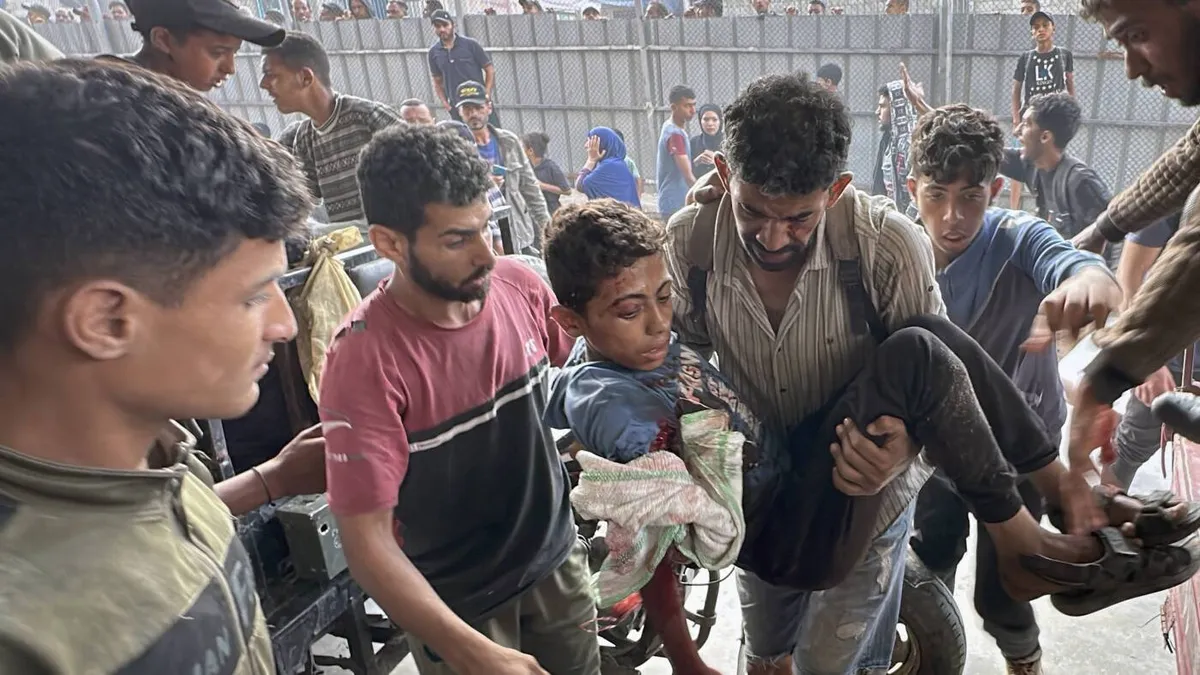
GAZA CITY and DUBAI — Israel's focus has shifted primarily towards its war with Iran, yet the conflict in Gaza continues to escalate. Recent reports indicate that Israeli troops are maintaining control over significant portions of Gaza territory. Tragically, Tuesday marked one of the deadliest days in recent weeks, particularly for Palestinians attempting to access food distribution sites and aid trucks. According to Gaza's health officials, at least 59 people lost their lives due to Israeli military drone strikes and artillery fire, with over 200 individuals injured while trying to secure food supplies.
A significant portion of the fatalities occurred at a crowded intersection in Khan Younis, a city in southern Gaza, where desperate crowds had gathered in anticipation of food trucks carrying flour. This incident represents the deadliest single event for those seeking food since late March, when Israel began permitting limited aid to flow into Gaza following a prolonged blockade lasting nearly three months. The Ministry of Health in Gaza reports that since March 27, Israeli actions targeting Palestinians seeking food aid have resulted in at least 400 deaths and over 3,000 injuries.
The ongoing conflict has led to a staggering overall death toll, with nearly 55,500 people killed since the outbreak of hostilities. Israel defends its stringent restrictions on food and aid, claiming that such measures are necessary to prevent support from reaching Hamas, which is believed to be holding approximately 20 living hostages and the remains of 33 deceased hostages captured during the October 7, 2023, attacks on Israel.
On Monday evening, the situation in Khan Younis escalated as word spread that aid trucks would arrive from Israel. Salim Saigaly, a 32-year-old teacher, traveled for hours from his tent encampment near the coast, hoping to secure flour to feed his four children. "Most of the time, I try to distract my children when they talk about hunger," he shared, "but often that doesn't work. So, I decided to take the risk and get some flour." Saigaly, along with many others, spent the night on the road, anxiously awaiting the trucks.
As the crowd surged toward the main roundabout at 9 a.m. on Tuesday, Israeli drones began firing on the gathering, followed by artillery shells. Saigaly described a horrifying scene: "Luckily for me, shrapnel did not hit me, but what actually fell over me were pieces of human flesh and bones. I saw so many dead people." He returned home empty-handed, narrowly escaping death.
The injured and deceased were transported to Nasser Hospital, the largest remaining hospital in Gaza, which has been a target of Israeli military actions throughout the conflict. Videos shared online depict bodies piled on donkey-drawn carts outside the emergency room. Nasser Hospital is already struggling to cope with hundreds of patients, including around 50 children in intensive care due to prior incidents. Doctors Without Borders reported that the maternity ward was evacuated to accommodate the influx of wounded individuals from the recent attack.
Due to limited supplies and overwhelming demand, the hospital is on the brink of collapse. "It could collapse at any moment," warned Aitor Zabalgogeazkoa, the emergency coordinator for Doctors Without Borders.
The U.N. has indicated that most aid reaching Gaza is quickly seized by desperate crowds before it can be distributed properly. Over the weekend, more than 20 individuals were killed in northern Gaza while waiting for U.N. aid trucks. Israel's military has not commented on these incidents, but most casualties over the past weeks have occurred near new food distribution sites managed by U.S. contractors and the Gaza Humanitarian Foundation (GHF).
GHF's operations have drawn thousands of Palestinians to areas deemed off-limits, where Israeli troops are stationed. In a statement, GHF acknowledged the dire situation, saying, "People are starving in Gaza, and their desperation can create hazardous conditions." The organization emphasized its commitment to delivering food as quickly as possible despite the chaotic circumstances.
Farhan Haq, a spokesperson for the U.N., criticized the current aid distribution mechanism, asserting that it must be reevaluated to prevent further loss of life. "We have made it clear since this scheme was developed that we did not think it would work," he stated, adding that the world can now see the consequences of this approach.
The situation in Gaza remains dire, with countless lives at stake as families struggle to find food amid the ongoing conflict. The international community watches closely as humanitarian efforts face immense challenges.